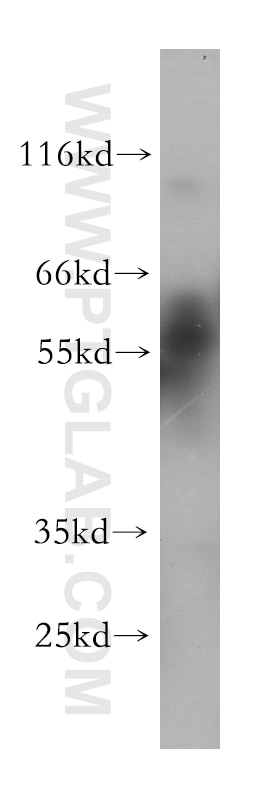Validation Data Gallery
Tested Applications
| Positive WB detected in | MCF7 cells |
Recommended dilution
| Application | Dilution |
|---|---|
| Western Blot (WB) | WB : 1:200-1:1000 |
| It is recommended that this reagent should be titrated in each testing system to obtain optimal results. | |
| Sample-dependent, Check data in validation data gallery. | |
Product Information
60119-1-Ig targets RARB in WB, ELISA applications and shows reactivity with human samples.
| Tested Reactivity | human |
| Host / Isotype | Mouse / IgG1 |
| Class | Monoclonal |
| Type | Antibody |
| Immunogen |
CatNo: Ag6013 Product name: Recombinant human RARB protein Source: e coli.-derived, PET28a Tag: 6*His Domain: 99-448 aa of BC060794 Sequence: EGCKGFFRRSIQKNMIYTCHRDKNCVINKVTRNRCQYCRLQKCFEVGMSKESVRNDRNKKKKETSKQECTESYEMTAELDDLTEKIRKAHQETFPSLCQLGKYTTNSSADHRVRLDLGLWDKFSELATKCIIKIVEFAKRLPGFTGLTIADQITLLKAACLDILILRICTRYTPEQDTMTFSDGLTLNRTQMHNAGFGPLTDLVFTFANQLLPLEMDDTETGLLSAICLICGDRQDLEEPTKVDKLQEPLLEALKIYIRKRRPSKPHMFPKILMKITDLRSISAKGAERVITLKMEIPGSMPPLIQEMLENSEGHEPLTPSSSGNTAEHSPSISPSSVENSGVSQSPLVQ 相同性解析による交差性が予測される生物種 |
| Full Name | retinoic acid receptor, beta |
| Calculated molecular weight | 50 kDa |
| GenBank accession number | BC060794 |
| Gene Symbol | RARB |
| Gene ID (NCBI) | 5915 |
| Conjugate | Unconjugated |
| Form | |
| Form | Liquid |
| Purification Method | Protein G purification |
| UNIPROT ID | P10826 |
| Storage Buffer | PBS with 0.02% sodium azide and 50% glycerol{{ptg:BufferTemp}}7.3 |
| Storage Conditions | Store at -20°C. Stable for one year after shipment. Aliquoting is unnecessary for -20oC storage. |
Background Information
Retinoic acid receptors (RARs) are important mediators of retinoid signaling in morphogenesis, development, and cell differentiation. Retinoic acid receptors bind as heterodimers to their target response elements in response to their ligands, all-trans or 9-cis retinoic acid, and regulate gene expression in various biological processes [PMID:12554770]. They can bind to the retinoic acid response elements (RARE) composed of tandem 5'-AGGTCA-3' sites known as DR1-DR5. In the absence or presence of hormone ligand, they act mainly as activators of gene expression due to weak binding to corepressors. In concert with RARG, RARs are required for skeletal growth, matrix homeostasis and growth plate function. RARB is one isotypes of RARs [PMID:12834868]
Protocols
| Product Specific Protocols | |
|---|---|
| WB protocol for RARB antibody 60119-1-Ig | Download protocol |
| Standard Protocols | |
|---|---|
| Click here to view our Standard Protocols |

